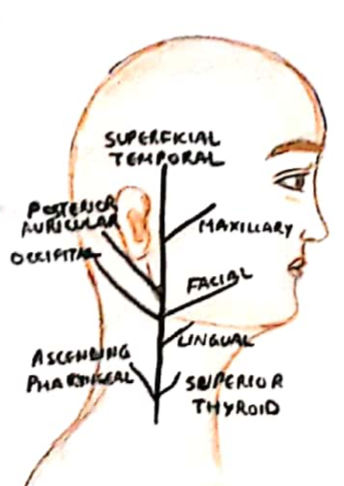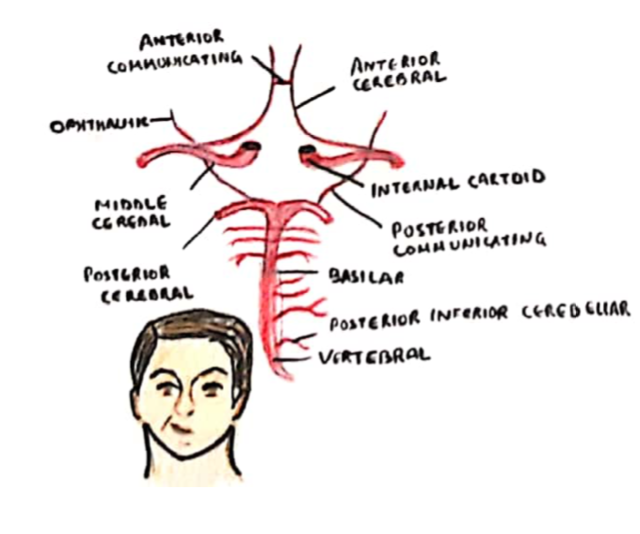Back to: Neurology
Cranial Nerves
12 cranial nerves supply the head and the neck, which have a variety of sensory and motor function
I – Olfactory
Foramen:
Cribriform plate
Modality:
Special Sensory
Function:
Smell
II – Optic
Foramen:
Optic canal
Modality:
Special Sensory
Function:
Vision
III – Occulomotor
Foramen:
Superior Orbital Fissure
Modality:
Special Sensory
Function:
Innervation to eye muscles –> Levator palpebrae superioris, superior, Medical & Inferior Oblique
Parasympathetic to ciliary muscles and sphincter pupillae
IV – Trochlear
Foramen:
Superior Orbital Fissure
Modality:
Somatomotor
Function:
Innervation to superior oblique
V – Trigeminal
Foramen:
Superior Orbital Fissure (Va)
Foramen Rotundum (Vb)
Foramen Ovale (Vc)
Modality:
Somatosensory and branchiomotor
Function:
Sensation –> Head and neck, paranasal sinuses, meninges, and external surface of tympanic membrane
Va gives frontal + lacriminal + nasociliary branches
Vb gives zygomatic + ganglionic + infraorbital branches
Motor Innervation to muscles of mastication:
Vc innervates muscles of mastication (pterygoids + masseter + temporalis)
Also gives sensory branches –> buccal, lingual, inferior alveolar + auriculotemporal
VI – Abducens
Foramen:
Superior Orbital Fissure
Modality:
Somatomotor
Function:
Innervation to lateral rectus
VII – Facial
Foramen:
Internal acoustic meatus
Modality:
Somatosenory
Viscerosensory
Visceromotor
Branchiomotor
Function:
Sensory –> Ear and tympanic membrane
Special sensory –> Taste to anterior two-thirds of tongue (chorda tympani)
Parasympathetic to sublingual and Submandibular glands
Motor innervation to muscles of facial expression:
– Temporal branch –> Orbicularis oculis and frontalis
– Zygomatic –> muscles of the eyelid
– Buccal –> buccinator, orbicularis oris
– Mandibular –> muscles of lower lip
– Cervical –> Platysma
VIII – Vestibulocochlear
Foramen:
Internal Acoustic Meatus
Modality:
Special Sensory
Function:
Hearing and balance
IX – Glossopharyngeal
Foramen:
Jugular Foramen
Modality:
Somatosensory
Viscerosensory
Branchiomotor
Visceromotor
Function:
Taste –> posterior third of tongue
Viscerosensory –> carotid bodies
Innervation to stylopharyngeus muscle
Parasympathetic to parotid gland
X – Vagus
Foramen:
Jugular Foramen
Modality:
Somatosensory
Viscerosensory
Branchiomotor
Visceromotor
Function:
Innervation to lateral rectus
Sensation –> External ear
Viscerosensory –> pharynx, larynx and viscera
Branchimotor –> taste in epiglottis and valleculae and innervation to the muscles of pharynx and larynx
Parasympathetic to neck, thorax and abdomen
XI – Accessory
Foramen:
Jugular Foramen
Modality:
Somatomotor
Function:
Innervation to trapezius and sternocleidomastoid
XII – Hypoglossal
Foramen:
Hypoglossal Canal
Modality:
Somatomotor
Function:
Innervation to tongue muscles:
– Genioglossus (protracts tongue)
– Styloglossus (retracts tongue)
– Hyoglossus (depresses tongue
Blood Supply
The head receives dual blood supply from internal carotid + vertebral arteries.
– These form an anastomotic connection known as the Circle of Willis.
– Arteries are in the subarachnoid space, and so rupture can give rise to a subarachnoid haemorrhage.
– Venous drainage is via dural sinuses, and then into the internal jugular vein
In addition, the external carotid artery also supplies blood to the face and neck.
– It gives rise to the superior thyroid, lingual and facial branches, before terminating in the superficial temporal and maxillary arteries.
– The maxillary artery gives off the middle meningeal artery, which proceeds to run through the foramen spinosum, deep to the pterion.





